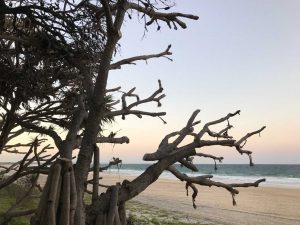Saving our pandanus
David Tardrew wrote in to the Community News wanting to know if Council were treating our pandanus trees.
“Walking on the beach the last few weeks I noticed large number of pandanus trees dying from ‘fatal yellow disease’, see in front of surf club for example. On closer inspection I observed nearly all trees on the beach are showing some signs of infection.”
David said, “I am aware of other councils doing a lot to treat the disease and save the trees – Bundaberg treated some 5000 trees.”
He says they are iconic to Rainbow Beach, “You only have to see at Teewah Beach all the dead pandanus. Council are spending a fortune on the Aquatic Centre, Rainbow Beach Park, Gympie Rattler to name a few, hopefully there are some dollars for the above.”
Cr Mark McDonald says Gympie Council is aware of the presence of the pandanus planthopper (Jamella australiae) in our coastal communities and is also conscious of its potential damage to our pandanus population.
National Parks information describes the flatids or pandanus leaf hoppers Jamella australiae which suck the pandanus sap from the leaf sheaths and exude honeydew.
This sugary substance encourages the growth of mould, and the terminal growth points of the leaves then rot, especially if the trees are already stressed by other environmental factors.
Jamella has been a problem across SE QLD and northern NSW coastal pandanus communities since being introduced in the early 1990s via an infected plant from north Queensland.
Cr McDonald continues, “As part of our ongoing management we will be engaging a leading specialist with knowledge of this insect to implement a pest management program in our coastal areas over the coming weeks, as part of an Integrated Pest Management strategy
“Their approach will be assessing our pandanus populations on public land (predominantly in our coastal areas) so we know the extent and level of any Jemella problem.”
Where required, releasing parasitised Jemella eggs (native) into infested populations when weather conditions improve (we are currently subject to unusually dry conditions and timing of release with the right conditions is critical) to disperse the predator wasp, which is harmless to humans, [will aim] to reduce the pest populations to manageable levels.
“The level of response will depend on pest numbers and conditions,” Cr McDonald explains.. “Preliminary inspections to date have found low levels of pest numbers but the final response will depend on what else we may find in other pandanus populations.
“No control measure eliminates the pest completely, however this will significantly reduce the numbers, tipping the balance in favour of the pandanus, increasing its health and disease resistance and improving its appearance.
“Council is undertaking ongoing mapping of pandanus locations on Council land and we are waiting for the right conditions to begin the program, as the extended dry has not been favourable for control measures.”







